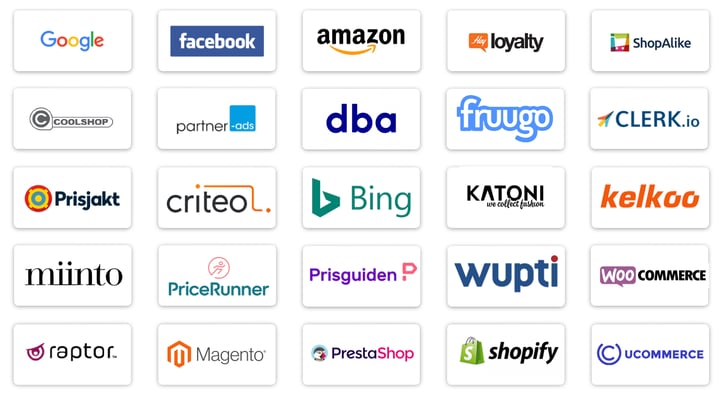How to Use GTINs in Google Shopping
Posted on May 20, 2019 (Last Updated: August 18, 2021)
Unique product identifiers are a way of defining exactly what it is your selling. As the name suggests, they uniquely distinguish products you are selling and help match your audience's search queries to your products.
Global Trade Item Numbers, or GTINs are perhaps the most common product identifiers used for Google Shopping. If you are familiar with ASIN (Amazon Standard Identification Number) then this is the same concept.
It might seem like an annoyance to get hold of GTINs if you don't have them for your products, but providing them means your ads will be more detailed and easier for users to find.
We're taking a look at what GTINs are, why they are so important and how to get hold of them for your product listings.
September 2019 Update on GTINs for Google Shopping
Starting September 30 Google will be making changes to enforcements for the Unique Product Identifier or GTIN requirements.
These changes will apply to Shopping ads in Austria, Belgium, Czech Republic, Denmark, France, Germany, Italy, Netherlands, Norway, Poland, Spain, Sweden, Switzerland and the UK.
Three changes will be introduced:
- Limited performance’ instead of ‘Disapproved’ for missing required UPIs.
Products missing required UPIs will no longer be ‘Disapproved’, they will be serving with ‘Limited performance’. - ‘identifier_exists’ = ‘false’ abuse enforcement.
Products for which the ‘identifier_exists’ attribute is incorrectly set to ‘false’ and for which there is sufficient evidence that a does UPI exist, will be disapproved. - disapproval for the use of the same GTIN across different offers within an account.
Several offers with the same GTIN which have different brands or different item group id, or several offers with the same GTIN/multipack/condition will be considered duplicate offers and will be disapproved.
You can learn more about how to fix incorrect identifiers via Google Help Center or speak to your CSS Provider for more information.
What is a GTIN?
There are several different types of unique numbers which can be categorized by Google under the term: GTIN.
EAN (European Article Number)
- Used primarily outside North America
- 13 digits
UPC (Universal Product Code)
- Used primarily in North America
- 12 digits
ISBN (International Standard Book Number)
- Used for Books
- Used Globally
- ISBN-10: 10 digits. This was depreciated in 2007 and not all books can be represented by this.
- ISBN-13: 13 digits
GTIN Requirements
Way back in ancient e-commerce history (2016), Google announced that all products submitted to the Merchant Center by sellers required GTINs, as well as the brand attribute for that item.
Manufacturer Part Numbers (MPNs) are also strongly recommended by Google but, as of yet, not mandatory (unless you cannot provide a GTIN - see further down in this article).
Submit a GTIN as defined in the official GS1 validation guide.
- Make sure that the check digit is present and correct using the GS1 Check digit calculator.
- Don’t submit a GTIN for a generic product.
- Don’t submit a GTIN for a product that doesn’t have a GTIN. If you’re the only seller of a product or if your product is a store brand, it generally won’t have a GTIN, so you don’t need to submit one.
- Submit separate GTINs for variation products. Products that have multiple variations in size, shape, color or material should each have their own unique GTIN.
Finding your product feeds' GTINs
If you don't already have a list of GTINs for your feed, it can be time-consuming to get hold of them (usually listed on the barcodes of your products packaging or via EAN search tools online).

Fortunately, WakeupData offer an on-demand web-crawl tool which lets you extract valuable information like this (as well as tags, images, metadata, etc), from across the web - crawling manufacturer sites and databases.
GTINS - A necessary evil?
For a first-time seller, it might seem like a major chore to trawl through your product listings looking for the unique ids.
But bear in mind, there is a reason channels like Google ask for GTINs. Once you have gotten hold of them they are a valuable resource for your online store - as hundreds of other shopping channels and online marketplace will also ask you for them.
Relevance is key - As with our guides to Optimize Product Titles on Google Shopping, Descriptions and Google Shopping Images: it's relevance that is the key to success.
The more info you can add to your ads, the more likely you'll be to show up in the right searches and get impressions from the right shoppers. Ultimately, adding as much relevant info will lead to more conversions.
What if your product doesn't have a GTIN?
In the words of Douglas Adams in The Hitchhiker's Guide to the Galaxy: 'Don't Panic'!
Some of your products might not have a GTIN. According to the Google Shopping support pages, these may include:
- Store brand products
- Replacement products
- Original equipment manufacturer (OEM) parts or replacements for OEM parts
- Custom-made or handmade products
- Books released before ISBN was approved as an ISO standard in 1970
- Vintage or antique products
- Preorder products (using the
conditionattribute)
So if your product falls into one of these categories, Google ask that you submit both the brand and mpn attributes instead - check out our guide to MPNs here.
Don't just assume that you don't have GTINs for some products though - it's best to check by using a simple webcrawl to look for relevant details.
If you run the risk and submit a product feed without GTINs, you'll get disapproved products and a lengthy waiting time to re-list your items.
GTINs for Google Shopping
GTINs are a valuable source of info for all online merchants. Not only is it obligatory to provide them for most sales channels, they are also an effective means of ensuring your listings are relevant and reaching the right audience.
Find out more about how to sell on Google Shopping or talk to our experts to find out about your selling options.





